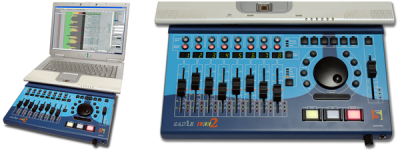
To conclude on the topic of podcasting without a budget or “I have too much money, tell me how to spend them”-podcasting I will talk a little about software, the room as well as processing and FX.
Software
This is going to sound like a joke with all the expensive stuff mentioned in the previous post, but if you can’t get a podcast to work with GarageBand then I can’t help you. If you still want to spend money and look at more in-depth editing tools then I could mention Digidesign Pro Tools, Merging Pyramix (which by the way have some purrty and pricey controllers), Magix Sequoia and Samplitude (which I know are getting a fair amount of use in broadcast), Steinberg Nuendo, or if you really want to be on the Apple route, Logic Studio. Another broadcast heavyweight is SADiE which recently was bought by Prism Sound.
Processing and FX
It’s hard to say what podcasters need in general. There are of course the standards, EQ, compression, de-essing, limiting and perhaps a gate. There are tons and tons of both software and hardware for these tasks. A personal favorite for the type of work a podcast is would be Flux products. They have great dynamics tools as well as perhaps the best software EQ I have ever heard in Epure. Other companies worth looking at would be Sonnox (previous Sony Oxford) and perhaps McDSP. Note that McDSP plug-ins are only available in Pro Tools format (RTAS, TDM). If you want to go the hardware route you can spend insane amounts of money, but I won’t be the accomplice of such evil deeds.
Other interesting things could be Audio Ease Speakerphone (earlier review on Audival and on ProToolerBlog) which would be great for all kinds of odd segments.
Listening
With all these FX, computers, sound interfaces, microphones and what-not’s you’ll need something to listen through. If you’re going the high-end route you should invest in a pair of proper studio monitors. They come in all price classes and an old advice in the music world is simply to spend as much as one can afford. I don’t know about that, but I definitely question the cheaper lines. Studio monitors are pricey but a great investment if you actually want to hear what’s going on. No matter how good stereo setup you have or how hip your computer speakers are they’re most likely a whole other animal. Headphones is necessary for many. I don’t know what to say about these other than that you should try out a couple to find some that are comfortable and that you can work with a long time. The sound should be good too of course 😉
The final ingredient is room treatment. If you want to build a serious room you should consult a acoustician. This is a whole science that you won’t learn over night by reading websites (yes, I have tried). Also think about separation. For instance, if you’re two or three persons talking in a segment you won’t want bleed from each others microphones that will just make it a lot more difficult to deal with later. There are room separators for this and other acoustic treating possibilities Another thing to watch out for is noise from all this fancy equipment I’ve made you buy! If you can keep it (including the computer) in a separate room that’s great.
Final thoughts
Why on earth would I write this? There can’t be a lot of potential podcasters who will afford this? And how many of these few would actually happen to read this blog? Well, for one thing I think it could perhaps be interesting to some to see what you could invest in, and have a look at the other side. I do believe that you can make great things with a modest setup of a USB microphones, GarageBand and a MacBook, but spending more on other things will help.
Originally posted on June 2, 2008 @ 8:32 am